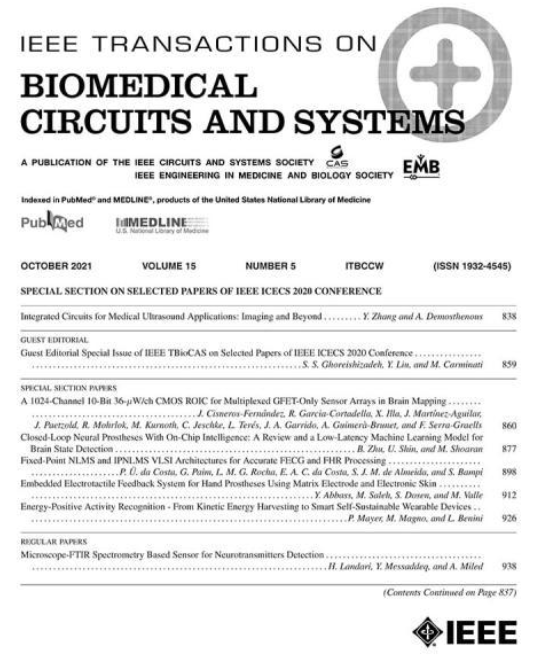A Bidirectional Neural Interface IC With Chopper Stabilized BioADC Array and Charge Balanced Stimulator
IF 4.9
2区 医学
Q2 ENGINEERING, BIOMEDICAL
IEEE Transactions on Biomedical Circuits and Systems
Pub Date : 2016-10-01
DOI:10.1109/TBCAS.2016.2614845
引用次数: 31
Abstract
We present a bidirectional neural interface with a 4-channel biopotential analog-to-digital converter (bioADC) and a 4-channel current-mode stimulator in 180 nm CMOS. The bioADC directly transduces microvolt biopotentials into a digital representation without a voltage-amplification stage. Each bioADC channel comprises a continuous-time first-order ΔΣ modulator with a chopper-stabilized OTA input and current feedback, followed by a second-order comb-filter decimator with programmable oversampling ratio. Each stimulator channel contains two independent digital-to-analog converters for anodic and cathodic current generation. A shared calibration circuit matches the amplitude of the anodic and cathodic currents for charge balancing. Powered from a 1.5 V supply, the analog and digital circuits in each recording channel draw on average 1.54 μA and 2.13 μA of supply current, respectively. The bioADCs achieve an SNR of 58 dB and a SFDR of >70 dB, for better than 9-b ENOB. Intracranial EEG recordings from an anesthetized rat are shown and compared to simultaneous recordings from a commercial reference system to validate performance in-vivo. Additionally, we demonstrate bidirectional operation by recording cardiac modulation induced through vagus nerve stimulation, and closed-loop control of cardiac rhythm. The micropower operation, direct digital readout, and integration of electrical stimulation circuits make this interface ideally suited for closed-loop neuromodulation applications.具有斩波稳定生物adc阵列和电荷平衡刺激器的双向神经接口集成电路
我们提出了一个双向神经接口,包含一个4通道生物电位模数转换器(bioADC)和一个4通道电流模式刺激器。生物adc直接将微伏生物电位转换为数字表示,而无需电压放大阶段。每个生物adc通道包括一个具有斩波稳定OTA输入和电流反馈的连续一阶ΔΣ调制器,然后是一个具有可编程过采样比的二阶梳状滤波器decimator。每个刺激通道包含两个独立的数模转换器,用于阳极和阴极电流的产生。共用校准电路匹配阳极和阴极电流的振幅,以实现电荷平衡。在1.5 V电源下,每个记录通道的模拟电路和数字电路的平均供电电流分别为1.54 μA和2.13 μA。生物adc的信噪比为58 dB, SFDR为70 dB,优于9-b ENOB。显示麻醉大鼠的颅内脑电图记录,并与商业参考系统的同步记录进行比较,以验证活体性能。此外,我们通过记录迷走神经刺激引起的心脏调节和心律闭环控制来证明双向操作。微功率操作,直接数字读出和电刺激电路的集成使该接口非常适合闭环神经调节应用。
本文章由计算机程序翻译,如有差异,请以英文原文为准。
求助全文
约1分钟内获得全文
求助全文
来源期刊

IEEE Transactions on Biomedical Circuits and Systems
工程技术-工程:电子与电气
CiteScore
10.00
自引率
13.70%
发文量
174
审稿时长
3 months
期刊介绍:
The IEEE Transactions on Biomedical Circuits and Systems addresses areas at the crossroads of Circuits and Systems and Life Sciences. The main emphasis is on microelectronic issues in a wide range of applications found in life sciences, physical sciences and engineering. The primary goal of the journal is to bridge the unique scientific and technical activities of the Circuits and Systems Society to a wide variety of related areas such as: • Bioelectronics • Implantable and wearable electronics like cochlear and retinal prosthesis, motor control, etc. • Biotechnology sensor circuits, integrated systems, and networks • Micropower imaging technology • BioMEMS • Lab-on-chip Bio-nanotechnology • Organic Semiconductors • Biomedical Engineering • Genomics and Proteomics • Neuromorphic Engineering • Smart sensors • Low power micro- and nanoelectronics • Mixed-mode system-on-chip • Wireless technology • Gene circuits and molecular circuits • System biology • Brain science and engineering: such as neuro-informatics, neural prosthesis, cognitive engineering, brain computer interface • Healthcare: information technology for biomedical, epidemiology, and other related life science applications. General, theoretical, and application-oriented papers in the abovementioned technical areas with a Circuits and Systems perspective are encouraged to publish in TBioCAS. Of special interest are biomedical-oriented papers with a Circuits and Systems angle.
 求助内容:
求助内容: 应助结果提醒方式:
应助结果提醒方式:


